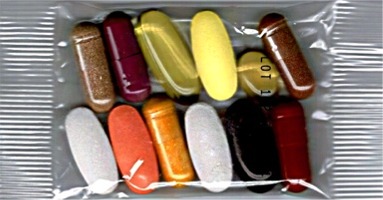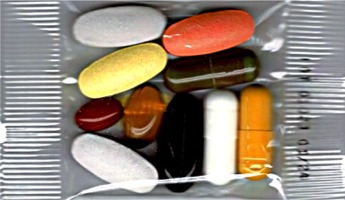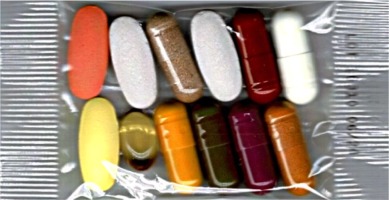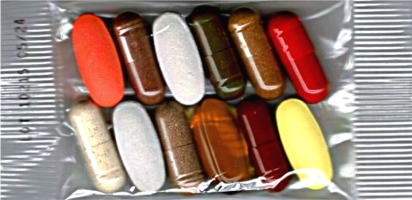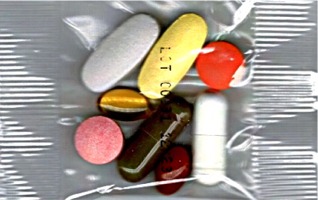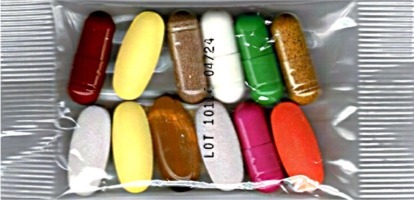In the 1800s, Sylvester W. Graham joined fame espousing the benefits of
roughage (Fiber) in the diet. His cracker is still with us, but surprisingly, dietary
fiber has had a harder time staying in favor. Since the turn of the century,
the fiber intake of Americans has steadily declined.
But today dietary fiber is making a comeback, as studies have multiplied
linking it to a lower risk for some of the leading causes of death in America.
Just what is this food component, and why do the experts tell us to eat more
of it?
What is Fiber?
Dietary fiber generally refers to parts of fruits, vegetables, grains, nuts
and legumes that can't be digested by humans. Meats and dairy products do not
contain fiber.
There are two basic types of fiber -- insoluble and soluble. Most
fiber-containing foods feature both, but one or the other type often
predominates in specific parts of a food and determines the characteristic
texture of that portion of the food.
For example, insoluble fibers produce the tough, chewy feel of wheat
kernels, popcorn, apple skin and nuts. Essential to the cellular structure of
plants, insoluble fibers include cellulose, hemicelluloses and ligin. They do
not dissolve in water.
Soluble fibers include pectin, gums, mucilages and algal polysaccharides.
Although pectin is part of cell walls, most soluble fibers are found within
plant cells. The gummy essence of oat bran and the mushy center of a cooked
kidney bean reflect both the soluble fiber content of those foods and the
ability of soluble fibers to soak up water.
The fiber content of a food varies according to the species of the plant
and stage of maturation, but seeds, berries, fruit skins and the bran layers
of cereal grains generally contain larger amounts of a plant's fiber.
ANR Formula One,
Two, Three, Four,
Five, Six, Seven
Heart, Alert, Maximus,
CATALOG
Fiber and Health
Although it wasn't called "fiber" until the 1950s, Hippocrates
realized the laxative effects of dietary fiber in 430 B.C.. Not until the
1960s, however, did scientists seriously begin to investigate the role of
fiber in health.
At that time, studies showed rural Africans, with diets higher in fiber
than the typical American or European diet, had a lower incidence of colon
cancer, diverticulosis, hemorrhoids, gallstones, appendicitis, diabetes and
some forms of heart disease than Americans or Europeans.
Studies since generally have indicated a positive relationship between a
high-fiber diet and good health, although it has been difficult to separate
the effects of fiber from other dietary and lifestyle factors that may play a
role in health.
"It's the total dietary pattern that has been linked to a reduced risk
of disease," says Bruce Trock, Ph.D., cancer epidemiologist at the Fox
Chase Cancer Center in Philadelphia. "Looking at all the studies
together, what you find is that a diet that's high in grains, vegetables and
fruits -- which also is a diet that's high in fiber -- is clearly protective
against colon cancer and possible cardiovascular diseases."
A high-fiber diet appears to reduce disease risk by increasing fecal bulk,
decreasing the transit time of food through the gastrointestinal tract,
reducing blood cholesterol levels and helping to control blood sugar levels.
With their distinct physical characteristics, insoluble and soluble fibers
work differently to produce these results.
Insoluble fibers seem to have their greatest impact on the health of the
colon or large intestine. Large amounts of insoluble fibers increase fecal
bulk and draw water into the large intestine. The result is a larger, softer
stool that exerts less pressure on the colon walls and is eliminated more
quickly. Indeed, the most well-established benefit of a high-fiber diet is in
the treatment and prevention of constipation. The reduced pressure also may
help prevent diverticulosis (small herniations in the colon wall that may
become inflamed). In addition, large amounts of insoluble fibers dilute the
concentration of potential carcinogens that may be present in the stool, and
the decreased transit time reduces the exposure of the intestinal wall to
those substances. Furthermore, insoluble fibers alter the pH of the large
intestine, interfering with microbial activity that produces carcinogens. The
combined effect may be a reduced risk of colon cancer.
Complementing the action of insoluble fibers, some soluble fibers also add
to fecal bulk and increase its water content. But soluble fiber's potential
for reducing blood cholesterol levels recently has grabbed the spotlight.
Studies have shown that diets rich in soluble fibers such as oat bran may help
reduce total cholesterol and low density lipoprotein (LDL) cholesterol in
people with both high and normal blood cholesterol levels.
Margo Denke, M.D., a nutrition research scientist at the University of
Texas Southwestern Medical Center, estimates that a diet low in fat and high
in soluble fiber may reduce an individual's blood cholesterol by 3 percent to
6 percent.
Soluble fibers appear to reduce blood cholesterol in two ways. First, they
prevent the reabsorption of vital bile acids from the small intestine. To
replace the lost bile acids, cholesterol is drawn from the body, thereby
reducing its cholesterol supply. Second, the fermentation of soluble fibers in
the intestine produces short-chain fatty acids which block the synthesis of
cholesterol.
Studies suggest soluble fibers also may help control the rise in blood
sugar following a meal and reduce insulin requirements in some patients with
diabetes mellitus. By increasing the viscosity of gastrointestinal contents,
soluble fibers retard gastric emptying, slowing the absorption of glucose in
the process.
ANR Formula One,
Two, Three, Four,
Five, Six, Seven
Heart, Alert, Maximus,
CATALOG
Measuring Fiber
Most food composition data bases today reflect the crude fiber content of
food, which is determined by subjecting food to a chemical treatment that
destroys large amounts of its insoluble fibers and almost all of its soluble
fibers. The resulting value seriously underestimates the true dietary fiber
content of food, which has been judged to be three to five times higher. This
created difficulties when attempting to evaluate fiber intake.
Methods that provide a more accurate reading are now in limited use in the
United States. The neutral detergent fiber method is primarily useful in
estimating insoluble fiber content. The total dietary fiber (TDF) method is
the only process that estimates total fiber content. The Association of
Official Analytical Chemists, which establishes all accepted U.S. methods for
determining nutrients in foods, advocates use of the TDF method.
Modification of the TDF method also allows determination of soluble and
insoluble fractions, but provisional data bases using figures derived from
this method currently do not reflect the type of fiber in a food. According to
the U.S. Department of Agriculture (USDA) Human Nutrition Information Service,
an update of the information is expected in the near future.
ANR Formula One,
Two, Three, Four,
Five, Six, Seven
Heart, Alert, Maximus,
CATALOG
Dietary Fiber Recommendations
While Americans currently consume an average of 11 grams of dietary fiber
daily, the National Cancer Institute advises an increase to 20 to 35 grams a
day. Although soluble fibers have received much attention lately, Trock
cautions against undue emphasis on any one type of fiber when planning a daily
diet. "People should increase the level of fiber by increasing foods from
all the vegetable, grain and fruit sources," he said.
Indeed, dietary guidelines issued by the USDA, the U.S. Department of
Health and Human Services, and the Surgeon General's office emphasize an
increased intake of fiber-rich foods in general. Fiber supplements are not
recommended as a way to meet dietary guidelines.
The Diet and Health report of the National Academy of Sciences has gone one
step further by specifying recommended amounts of foods high in fiber. It
advises a daily intake of five or more servings of fruits and vegetables and
six or more servings of whole grain breads and cereals and legumes.
Health professionals caution against making an immediate leap from a
low-fiber intake to recommended levels. Increasing fiber consumption too
rapidly can result in flatulence, cramping and intestinal distention.
Undesirable side effects may be avoided through the gradual addition of fiber
to the diet along with an adequate fluid intake.
Although concerns that fiber may interfere with the absorption of trace
minerals have been voiced, studies show people consuming well-balanced and
varied diets high in fiber are unlikely to experience mineral deficiencies.
While fiber does seem significant to human health, scientists stress its
interplay with other factors must not be ignored. The effects of heredity, the
quality of the overall diet and habits such as smoking and exercise can
outweigh any single dietary modification. The best guarantee is an integrated
effort that includes a high-fiber diet as part of a healthy lifestyle.
Reprinted from the International Food Information Council Foundation, 1990
Also see:
Phytochemicals: Nutrients Of
The Future
Antioxidants: An Antidote to
Aging?
Better Eating for Better Aging
Nutrition Is Key To Successful
Aging: Kidd
Latest Concepts in Nutrition
Life Long Weight Management
for Health & Happiness
10 Tips to Healthy Eating
New Perspectives on Diet and
Cancer
Upbeat on Fiber for Longer
Life & Better Health
A Refresher On Water for Long
Life & Health
Reference Guide for Vitamins
Reference Guide for Minerals
Reference Guide for Herbs
Reference Guide for Amino
Acids
Reference Guide for Special
Nutrients
Reference Guide for
Anti-Oxidants
Reference Guide for Nutritional
Greens
Reference Guide for Digestive
Nutrients
Reference Guide for Dietary
Fibers
Suggested Readings and Guide
References
ANR Formula One,
Two, Three, Four,
Five, Six, Seven
Heart, Alert, Maximus,
CATALOG
|
